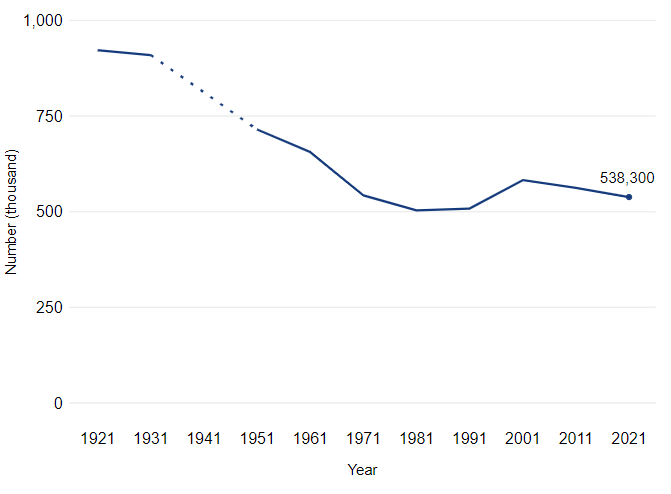Census data shows percentage of Welsh speakers dropped over the last 10 years

The percentage of Welsh speakers living in Wales has dropped over the last 10 years, the 2021 Census has revealed.
On 21 March 2021 an estimated 538,300 “usual residents” in Wales aged three and above reported being able to speak Welsh.
This is the equivalent of 17.8 per cent of the population.
However this is a drop of 23,000 on the previous Census carried out in 2011.
Wales’ population is just over three million, with the Welsh Government aiming to have one million Welsh speakers by 2050.
But the 2021 findings show that more needs to be done to reach this target, with the percentage of people aged three years or older able to speak Welsh was the “lowest ever recorded” in a Census.

The decrease in both the number and percentage of people able to speak Welsh is “mainly being driven by a fall among children and young people who reported as being able to speak Welsh”, the Office of National Statistic (ONS) found.
There was a six per cent drop in the number of children aged between five and 15 able to speak Welsh between 2011 and 2021.
A similar decrease was also seen in three to four year olds.
Despite “small increases” in those aged between 16 and 19 and 20 to 44 speaking Welsh, there were also decreases in Welsh speakers in the older age groups.
Overall the ONS said that the “age profile of adults who are able to speak Welsh appears to be changing”.
In 2021, among people aged 20 years or older, 20 to 44 year olds was the age group most likely to be able to speak Welsh (16.5 per cent).
This was different from 2011, where the percentage was highest for people aged 75 years or older (17.5 per cent).
The Census also found that although the population of Wales is estimated to have increased by 1.4 per cent since 2011, this is due to more people moving into Wales than leaving Wales.

There were more people who were born outside Wales living here in 2021 than in 2011.
The ONS said that that “people born outside Wales are much less likely to report being able to speak Welsh than people born in Wales.”
The highest percentages of Welsh speakers were in north-west Wales, with 64.4 per cent in Gwynedd, and 55.8 per cent on the Isle of Anglesey.
However there was an overall decrease in all other parts of Wales between 2011 and 2021 except Cardiff, Vale of Glamorgan, Rhondda Cynon Taf and Merthyr Tydfil.
In Flintshire, there was a 1.6 per cent drop in the number of Welsh speakers aged three and above.
This is includes a 7.5 per cent drop in ages 3 to 15 and a 1.2 per cent decrease in the over 65s.
Ages 16 to 64 was the only group remaining the same as 2011.
The ONS said: “The way in which people perceive and report on their skills can be influenced by a number of factors and can vary from person to person.
“In some cases, especially for children, Welsh language ability was reported by another person, for example, a parent or guardian.
“Their assessment of the person’s Welsh language ability may not be the same as that of the person themselves.
“Census 2021 was held during the coronavirus (COVID-19) pandemic, on 21 March 2021.
“This followed periods of lockdown, remote learning for children and many people were working from home. It is not known how the pandemic may have impacted people’s reported Welsh language ability (or perception of the Welsh language ability of others).”
In cooperation with percentage-calculator.app
Spotted something? Got a story? Email: [email protected]
Latest News
